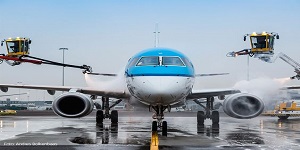
Ice is a contributing factor to many airplane accidents so How Dangerous Is Flying In Ice? I am sure that some people are uncomfortable flying in storms and winter storms can be unnerving because of reduced visibility, snow, and ice. Let’s look at why.
How Dangerous Is Flying In Ice?
Flying into known icing is the most dangerous thing a Pilot can do. It is insidious and completely unpredictable. It can destroy lift, block air intakes, and rapidly cause an accident.
1. Is Flying In Ice Safe?
As a Pilot with little experience, you may wonder why it’s so dangerous to fly in ice.
That does depend upon the way the aircraft is equipped and the experience required to venture into possible icing conditions. By equipment, I mean an aircraft that is certified to fly in known icing conditions.
Take note that Airliners are not as susceptible to icing because they generally fly above the weather. That reduces their exposure to the ice to climbs and descents through the lower altitudes. Aircraft that operate in lower altitudes are at greater risk.
What about the experience? Unfortunately, there is no way to gain experience without flying in the weather and ice. But that is the best teacher. Trial by fire.
I flew thousands of hours at night in all types of weather in the Rocky Mountains where I encountered ice and everything else that Nature could throw at me including a few encounters with severe icing. I will tell you that I would never want to fly in that again. Ice tried to kill me.
2. Necessary Equipment For Known Icing.
Aircraft have anti-icing systems or deicing systems and to fly in ice the aircraft must be equipped with one or both installed and properly working.
Anti-ice is windshield and pitot tubes that are on for every flight Windshield anti-ice will even help prevent a possible glass shatter in the event of a bird strike.
Large aircraft and corporate jet’s anti-ice are hot wings that are fed by bleed air that is fed by the airplane engines.
Other aircraft have pneumatic boots on wings and tails that are operated when ice has built up on the surfaces. They operate by inflating the boot to shed ice build-up.
Caution should be exercised when using inflatable boots because if they are used too soon and do not shed the ice the boot will not work well if at all. Waiting too long can lead to the same issue. Your trip should not continue into more ice unless you can remove the ice.
Remember that when you are flying in ice the tail can be the biggest enemy because the ice will form on the tail twice as rapidly as the wings and you cannot see the tail. If you ever find yourself in this kind of weather you will realize just how dangerous it is to fly in ice. This video is well worth the time.
As in everything associated with flying, the most important equipment on any flight is you. Always be at the top of your game because an emergency in flight may require everything you have to avoid an accident.
3. Types Of Ice.
Three types of ice are significant in icing conditions, clear, rime, and mixed. Whenever you are going flying in any type of icing and you make a PIREP, (Pilot Report), you will need to specify the type of ice, its severity, and altitudes where ice was encountered, plus your present outside temperature.
The majority of ice I encountered was mixed but the most severe icing I ever encountered was by definition clear.
As boring as it may seem to you, study weather because you will need all the knowledge you gain. Every pilot will benefit from studying meteorology.
4. Weather Briefings.
Whenever you are going flying in any type of weather, even severe clear, make a practice of talking to a weather specialist. That guarantees you have the most up-to-date weather and makes sure you did not miss anything.
You will have all the latest weather plus notices to air persons (NOTAMS) and Pilot Reports, (PIREPS).
I always reviewed all available weather and then checked in with flight service even when flying with an Airline.
Airlines have dispatchers that also have the weather for aircrews, so each flight has up-to-date weather at all times when on the ground and airborne through ACARS, Aircraft Communications And Reporting System.
5. FAA Weather Minimums.
I spent so much time flying the Rocky Mountains in Colorado, Montana, Wyoming, and Utah, that I built a pretty good sense of flying in the most adverse mountain conditions. I found out why it’s so dangerous to fly in ice. Most of all I stayed alive.
The only thing that stopped any of the Part 135 company pilots from flying was the weather at the destination. If it was below minimums or forecast to be so on arrival then we were ground halted until we could legally fly. Plus severe icing reports ground stopped everybody. But, that is rare.
(There are a couple of other rules about forecasted weather), which you can read here.
The rule that affected us the most was 135.219 below.
135.219 IFR Destination airport weather minimums.
No person may take off an aircraft under IFR or begin an IFR or over-the-top operation unless the latest weather reports or forecasts, or any combination of them, indicate that weather conditions at the estimated time of arrival at the next airport of intended landing will be at or above authorized IFR landing minimums.
The way around that was to file a “round-robin,” (Destination becomes the departure airport) from base to the desired destination and hope like hell the weather came up to at least legal minimums so we could land. Otherwise, we went to a designated alternate airport.
It was unusual for us not to be able to land because the weather nearly always improved.
This brings up the ice reports. Unless severe icing is reported on your route of flight you may go. You may not see even a trace of ice.
FAR Part 91 does not have these restrictions so do read the rules. Part 91 can be read here.
Some Final Considerations.
I stated at the beginning of this article that the weather is insidious. Weather reports can be wrong and pilot reports may be outdated minutes after being transmitted. Why would this be true?
Well, for one we have all heard a weather report on the news that was far different from what the weather really is. This is not to say that all forecasts are wrong. I am simply saying that a pilot must use “Common Sense”
The second consideration is that weather changes rapidly and a Pilot Report may not be accurate.
An example of this is a report that says “light to moderate rime at 10,000 feet MSL,” and when you arrive in the same vicinity you experience very light ice or no ice at all. However, you may find severe ice. Always be situationally aware.
Never use an autopilot in icing conditions! Yes, I said never. You will not have any “feel” for the aircraft and what is happening putting you in a situation from which you may not be able to extricate yourself.
I always hand flew the airplane in weather. I always paid close attention to the airplane on autopilot by increasing my scan rate.
